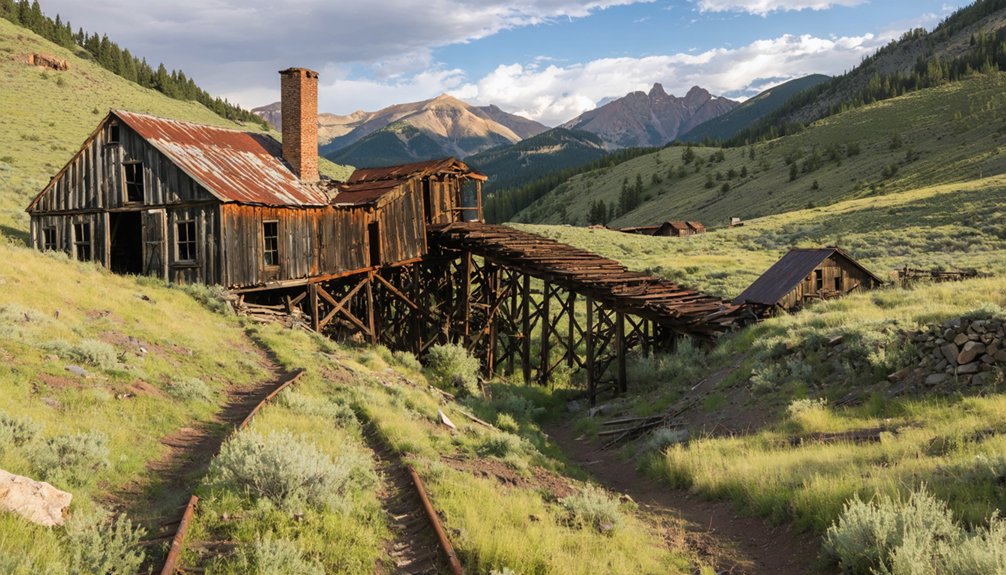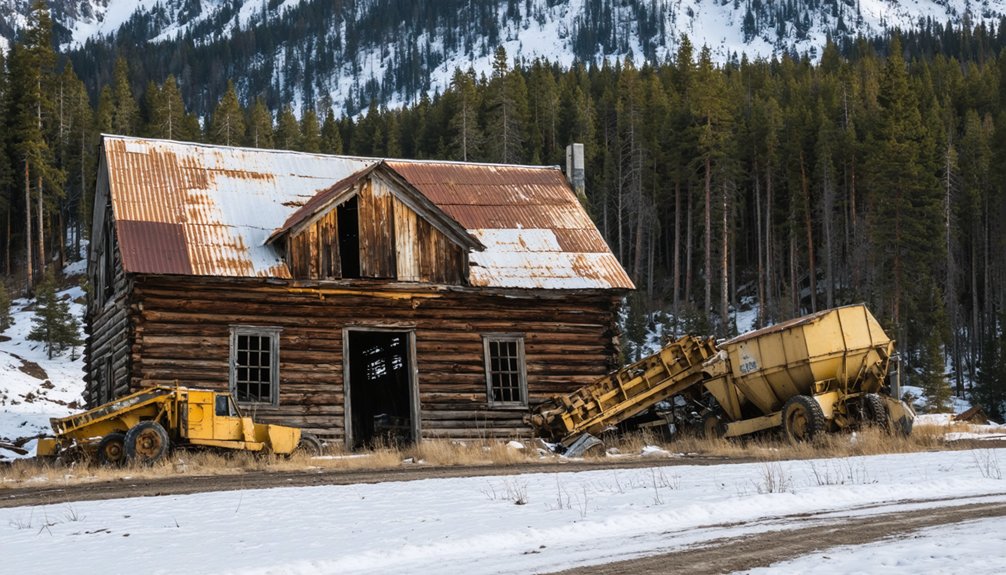Stibnite, Idaho, emerges as one of America’s most significant wartime mining settlements. You’ll find its origins in 1899, but it reached its pinnacle during World War II when it produced 90% of the nation’s antimony and 40% of its tungsten. The Bradley Mining Company transformed this remote location into a thriving company town of 1,500 residents with modern amenities. After the war’s end, Stibnite gradually declined until its abandonment in 1997. The site’s complex legacy spans strategic minerals, company town life, and environmental challenges.
Key Takeaways
- Stibnite was a thriving mining town that produced 90% of America’s antimony during World War II before becoming abandoned in 1997.
- The town peaked at 1,500 residents during WWII with amenities including stores, schools, hospital, and recreation facilities.
- Mining operations ceased completely in 1997, leaving behind significant environmental damage and contaminated waste sites.
- The town transformed from bustling wartime mining hub to ghost town after WWII ended and mineral demand dropped.
- Modern revival efforts by Perpetua Resources face challenges balancing economic development with environmental conservation concerns.
The Birth of a Mining Frontier
While Idaho’s gold rush era was already in full swing, mining operations first emerged at Stibnite in 1899, marking the beginning of what would become a significant mining frontier.
You’ll find the early pioneers faced substantial challenges, as mining technology hadn’t yet caught up with the site’s complex mineral deposits. Located in rugged terrain about 15 miles east of Yellowpine, the area’s potential remained largely untapped until the Thunder Mountain Gold Rush of 1900 drew increased attention.
The area’s rich deposits of gold and antimony would later prove crucial during World War II. From 1914 to 1927, you’d see mining claims changing hands frequently as prospectors and companies sought to access the site’s wealth.
The Meadow Creek Mine emerged as one of the first developments, setting the stage for the area’s transformation from wilderness to a bustling mining district. The rise in antimony demand during World War I prompted Albert Hennessy to stake additional mining claims in the area.
World War II’s Strategic Mining Hub
As World War II erupted across Europe and Asia, Stibnite transformed into America’s most crucial strategic mining operation, producing 90% of the nation’s antimony and 40% of its tungsten between 1941-1945. The U.S. Army and Navy Munitions Board oversaw these critical wartime materials, which were essential for manufacturing armor-piercing shells and flame-retardant military equipment. The Bradley Mining Company pioneered innovative flotation processes to efficiently extract gold and antimony from the ore. German forces relied heavily on Chinese tungsten supplies until the U.S. developed domestic sources at Stibnite.
- The workforce swelled to 1,500 people running 24-hour mining operations.
- Mining shifted from underground to large-scale open-pit extraction.
- You’d find continuous production under strict government control and distribution.
- The mine’s output helped shorten WWII by approximately one year.
The intensity of wartime production came at an environmental cost, with substantial sediment runoff into the Salmon River system and disrupted fish passages that would impact the region for decades to come.
Life in a Company Town
Beyond its military significance, Stibnite functioned as a fully operational company town that supported over 1,500 residents at its wartime peak.
You’d find five distinct residential districts, including Monday Camp and Forest Grove, where workers lived in wood-frame houses, bunkhouses, and house tents. The town’s hydroelectric power plant enabled continuous operations and modern amenities for residents.
Community engagement flourished through the town’s robust infrastructure. You could access the hospital – Valley County’s only medical facility at the time – or enjoy the recreation hall and bowling alley after your shift. Today’s Perpetua Resources continues this legacy of community involvement.
Despite its isolation, Stibnite’s medical facilities and recreational venues created a vibrant community life for its mining families.
Labor relations were structured around 24-hour mining operations, with workers specializing in both underground and open-pit techniques. The elected Village Board governed local affairs, while company-operated stores and a post office met your daily needs.
Despite the remote location, families enjoyed basic amenities, education, and social activities that fostered a strong mining community.
Environmental Legacy and Challenges
You’ll find stark evidence of mining’s environmental toll at Stibnite, where over a century of operations left behind contaminated waste sites and blocked fish passages in critical waterways.
Historic mining activities destroyed more than 20% of the habitat for endangered species like Chinook salmon and bull trout, with the site accumulating 258 water quality violations between 1994-1996 alone. Mining operations in the area finally ceased in 1997, leaving significant environmental damage that persists today.
While current restoration plans propose to address fish passage issues, the proposed reopening of mining operations by Perpetua Resources presents new challenges, as their plans would impact over 70% of sensitive fish habitat near the South Fork Salmon River headwaters. The site borders the Frank Church Wilderness, making environmental concerns particularly acute for this protected region.
Historic Mining Impact
While Stibnite’s mining operations ceased decades ago, the environmental legacy continues to plague the region with severe ecological impacts. The mining techniques used over a century of extraction have left an indelible mark on the landscape, with economic impacts felt long after operations ended. The transition from underground to open-pit mining in 1938 dramatically altered the area’s topography. Mining activities have introduced toxic contaminants like arsenic and lead into the surrounding environment.
- Over 10.5 million tons of unlined waste rock and tailings continue to contaminate both surface and groundwater systems.
- Historic dam failures and mining waste have severely impacted local streams, with Blowout Creek remaining the largest source of sedimentation.
- Legacy mining created multiple open pits, including the Yellow Pine pit that’s now filled with 80 feet of sediment, blocking critical fish passages.
- The area suffers from extensive heavy metal contamination, including mercury, with 258 water quality violations documented in just two years during the 1990s.
Fish Passage Restoration Plans
In response to the severe environmental damage, extensive restoration plans now focus on reestablishing fish passages throughout the Stibnite mining site.
You’ll find the century-old Yellow Pine Pit being transformed with an interim tunnel to maintain fish migration while mining operations continue. Once complete, they’ll backfill the pit to restore permanent passage.
The restoration will open over 21 miles of previously blocked fish habitat, including 7 miles for Bull Trout, 13 miles for Chinook, and 8 miles for Steelhead spawning.
Stream restoration plans incorporate dynamic channel migration, increasing stream functional units by 9.5%.
They’re tackling historic tailings and cyanide heap removal to reduce water contamination, while using local glacial till and woody debris amendments to rebuild soil profiles essential for stable stream banks.
From Boom to Abandonment

During World War II, you’d find over 1,500 people living and working in Stibnite, transforming what was once a remote mining camp into a bustling company town with schools, stores, and housing.
After the war’s end in 1945, you’ll see how quickly the population dwindled as antimony and tungsten demand plummeted, leading to mass layoffs and departures.
Population Peak and Decline
As World War II drove unprecedented demand for antimony and tungsten, Stibnite’s population surged to its peak of 1,500 residents, transforming the remote Idaho mining settlement into a bustling company town.
The demographic shifts reflected economic fluctuations tied directly to wartime mineral needs, but you’d have seen this prosperity fade rapidly after 1945 as the population dropped below 600.
- The Bradley Mining Company provided free utilities, housing, and a fully-staffed hospital during peak operations.
- Mining technology evolved from underground tunnels to large-scale open pit extraction.
- The town maintained an elected village board and robust community infrastructure.
- Post-war decline continued steadily until complete abandonment in 1997.
Today, you’ll find only remnants of this once-thriving mining community, with deteriorating structures marking where thousands once lived and worked.
Rapid Post-War Exodus
While wartime production drove Stibnite’s remarkable growth, the sudden end of World War II triggered a swift and dramatic exodus from the mining town. As the U.S. government deprioritized tungsten and antimony production in 1945, economic shifts devastated the community’s sole industry.
You’d have witnessed dramatic migration patterns as miners and their families abandoned their homes, seeking work elsewhere when round-the-clock operations ceased.
The town’s infrastructure rapidly deteriorated as buildings were dismantled and materials salvaged. By 1955, the once-bustling mine had completely shuttered its large-scale operations.
Without economic diversification to sustain the population, Stibnite’s transformation into a ghost town was inevitable. The environmental damage from abandoned mining operations, including sediment erosion and blocked fish passages, further sealed the town’s fate.
Modern Revival and Conservation Efforts
Despite its ghost town status, Stibnite has experienced renewed interest through modern mining initiatives, particularly from Perpetua Resources (formerly Midas Gold), which began test drilling operations in 2009.
The project’s modern sustainability approach aims to address historical environmental impacts while pursuing new mining opportunities.
- A proposed fish tunnel would restore salmon habitats in the East Fork of the South Fork of the Salmon River
- Community engagement efforts balance tourism potential with preservation of mining heritage
- The Nez Perce Tribe has mounted legal challenges over land rights and environmental concerns
- Environmental groups, including the Idaho Conservation League, actively monitor development plans
This complex revival faces ongoing debates between economic development and conservation, with stakeholders working to find solutions that respect both the area’s rich mining history and its natural resources.
Frequently Asked Questions
What Was the Average Salary of Miners Working in Stibnite During WWII?
You’d find miner wages during the wartime economy averaged around $1,300-2,300 annually, though exact Stibnite figures aren’t documented. This estimate aligns with typical U.S. manufacturing wages of that era.
Are There Any Remaining Original Structures Still Standing in Stibnite Today?
You’ll find two historically preserved structures: the 1917 Mountain Chief cabin with full lap log construction and the 1930 Olson Cabin featuring V-notched logs of architectural significance.
What Were the Most Common Diseases or Medical Conditions Treated at Stibnite’s Hospital?
A thousand maladies passed through those doors, but you’d find disease prevalence centered on mining injuries, respiratory conditions from dust exposure, and infectious diseases. Hospital services primarily treated work-related trauma and pneumoconiosis.
How Did Families Obtain Basic Supplies During Winter Months in Isolated Stibnite?
You’d rely on the company store’s stockpiled goods, postal deliveries, preserved foods from summer gardens, hunted game, and pre-winter freight shipments to manage winter supplies and isolation challenges in harsh conditions.
What Recreational Activities Did Children and Teenagers Enjoy in Stibnite?
You’d find yourself joining outdoor games near the mountains, hitting the bowling alley, sledding in winter, fishing local streams, and gathering at the recreation center for community events and dances.
References
- https://yellowpinetimes.wordpress.com/2022/06/26/idaho-history-june-26-2022/
- https://en.wikipedia.org/wiki/Stibnite_Mining_District
- https://www.idahorivers.org/stibnite-history
- https://history.idaho.gov/wp-content/uploads/2018/09/Stibnite_Historic_District_87001186.pdf
- https://www.youtube.com/watch?v=OOvdW9kLu3A
- https://storymaps.arcgis.com/stories/e994e87691154dd5af1375fba7c425f6
- https://brownandcaldwell.com/2022/05/the-journey-of-idahos-stibnite-mine/
- https://pubs.usgs.gov/bul/0969f/report.pdf
- https://yellowpinetimes.wordpress.com/2025/10/19/idaho-history-oct-19-2025/
- https://perpetuaresources.com/project/stibnite-history/



